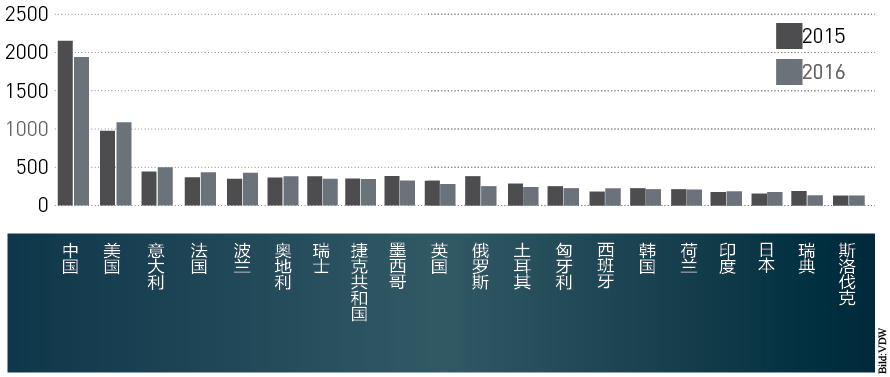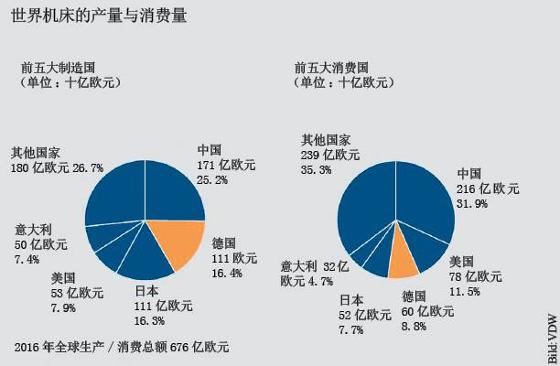Summary In 2016, the development of the world's top ten machine tool markets varied. The Asian regional market has to cope with the effects of the weak state of the Chinese market. Despite this, it still cannot shake Asia's leading position in the global machine tool market. Machine tool builders can't get 2016...
In 2016, the development of the world's top ten machine tool markets varied. The Asian regional market has to cope with the effects of the weak state of the Chinese market. Despite this, it still cannot shake Asia's leading position in the global machine tool market. Machine tool builders are unable to maintain the 2016 global industry level at the 2015 level. The record-breaking achievements of 2012 have also become an unreachable history. Global machine tool production fell by 2.2% last year, and total production fell to 67.6 billion euros. The German machine tool industry maintained a high level in 2016 and a very stable market, and is expected to continue to achieve strong growth in 2017, but the rest of the global machine tool market is very uneven.

Almost one-third of the global market share is based on VDW's description in its 2016 market report. In 2016, China's machine tool production increased by 12%, and the current total output value reached 17.1 billion euros (Germany: 11.1 billion euros). It accounts for 25.2% of the global market. The demand rate of China's machine tool market is as high as 31.9%, or the market demand share is 21.6 billion euros, which indicates that China's demand for machine tools remains high. In short, the main demand in the world machine tool market (54.1% or a share of demand of 36.6 billion euros) is still in Asia. As the market continues to demand higher quality and more automated products, German machine tool builders will benefit more.
China's products in the field of molding manufacturing technology are very strong, which can be verified from China's 33.4% (or 6.9 billion euros) market share in the global molding technology market. In contrast, Germany, in its second position, has a much lower total output than China, at 2.9 billion euros. In the field of cutting technology, China has upgraded its own strength. In 2016, the global cutting industry produced a total value of 47.1 billion euros. For the first time in the world, the world's number one position in cutting technology is Japan, but in 2016, China surpassed Japan for the first time with a share of 21.7% of the world market and a total output of 10.2 billion euros. Japan fell to the second place with a total output of 9.4 billion euros and a global market share of 19.9%.
Japanese manufacturers suffered heavy losses Japan's total machine tool output fell sharply in 2016, from 12 billion euros in 2015 to 11 billion euros in 2016. Therefore, in the ranking of the world's largest machine tool manufacturing countries, Japan's second ranking also gave Germany. Japanese manufacturers are suffering from the severe impact of the weak Asian machine tool sales market.
But as the demand in the Chinese market recovers, this situation should change in the coming year. Orders for cutting machinery have increased, for example, after a 16% overall decline in 2016, orders for cutting equipment increased by 12% in the first quarter of 2017. Other countries will also feel the impact of the weak domestic market in Asia. The output of cutting machinery in South Korea fell by a fifth, and it fell to the sixth place in the world. The consumption of machine tool products also dropped from 4 billion euros in 2015 to 3.2 billion euros in 2016. In the past 15 years, South Korea has achieved a significant increase in machine tool manufacturing capacity. In 2011, South Korea's machine tool production reached an all-time high. Today, South Korea is unable to reproduce the 2011 production level and is related to the slowdown of China's economic development. South Korea's production of machine tools in 2016 fell by 21% compared to 2011.
Similarly, Taiwan's industry data has also seen a major decline, with total production falling from 3.7 billion euros in 2015 to 3.4 billion euros in 2016. It is reported that Switzerland has also experienced the same situation. The world's eighth-ranked machine tool manufacturer has a total value of 2.6 billion euros in machine tools in 2016, compared with 2.8 billion euros in 2015.

German global export champion of machine tool products In terms of machine tool product exports, Japan has to recognize the strength of German manufacturers, and German manufacturers won the title of global machine tool product export champion in 2016. Due to the weakness of the Asian market, the export value of Japanese machine tool products fell by 18%, while the export value of German machine tool products was 7.6 billion euros, a slight decrease of 3%. Germany therefore occupied the first place in the global export of machine tool products. Italy ranks third with exports of 3 billion euros.
In terms of import and consumption of machine tools, the United States is the second largest market in the world, and the total consumption of machine tools is less than one-third of that of the first place in China. In 2016, total US machine tool consumption fell by 1% to 7.8 billion euros. At the same time, the import of US machine tool products also fell by 8%, which made German exporters quite disappointed. From 2015 to 2016, US imports of machine tool products fell from 4.7 billion euros to 4.3 billion euros. In the United States, sales of domestic machine tool products mainly support the machine tool product market. The consumption of machine tool products in the United States accounts for 60% of the total output value of domestic machine tools. Despite this, the turnover of the US machine tool product market has remained at a high level since 2012.
Italian national plan is gradually gaining results The Italian Machine Tool, Robotics and Automation Manufacturers Association (Ucimu) pointed out that the Italian machine tool industry has achieved gratifying development. This provides quarterly order indices to professional associations in machine tools, robotics and automation. The data shows that the total number of machine tool orders in Italy in the first quarter of 2017 increased by 5.1% compared to the same period.
Compared with the same period in 2016, the absolute index value is stable at 187.7, much higher than the 2010 average of 100. According to the information provided by the association, the demand in the domestic market showed strong growth, and the order volume increased by 22.2%. However, it is understood that the situation in foreign markets remains largely unchanged, and the corresponding index value has increased by 0.3%.
Ucimu noted the implementation of the Italian Industry 4.0 National Plan and its positive development impact on the national machine tool industry. According to the information obtained, after experiencing the decline in the fourth quarter of 2016, Italy’s market demand for equipment production systems has now recovered significantly, which confirms the positive development trend in the Italian domestic market. Some important tax incentives can be further utilized, such as a significant reduction in government revenues.
In the world ranking of the world's largest machine tool producers, Italy has surpassed South Korea to reach the fifth place. The global machine tool production in the southern neighbouring countries of Italy is 5 billion euros, accounting for 7.4% of the global total. According to the data of the German Machine Tool Manufacturers Association (VDW), the consumption of Italian machine tool products has also increased, accounting for 4.7% of the global machine tool consumption (also in the fifth place), only exceeding 1 million euros in South Korea.
In the field of molding manufacturing technology, Italy ranks third in the world. The absolute leader in the machine tool production and accessories market is still China.
Mexico, India and Russia's machine tool technology industry, a market research report from VDW reported that Mexico's machine tool industry imports have also increased. Mexico is focusing on the automotive industry, and imports of machine tools from the country have increased from 2 billion euros to 2.1 billion euros. In terms of consumption of machine tools, Mexico has occupied the seventh place in the world with a consumption of 2.2 billion euros, ranking behind South Korea.
In India, similar to the situation in Italy, its domestic reforms have begun to bear fruit. The consumption of Indian machine tool products increased from 1.5 billion euros to 1.7 billion euros.
Russia is a loser in the global machine tool market competition in 2016. The consumption of Russian machine tool products continued to fall, down 16%, and the consumption was around 1.3 billion euros. In comparison, the country’s consumption of machine tool products in 2014 was 1.8 billion euros. Russia ranks last in the world's top ten machine tool markets.
Measuring Tape,Smart Measuring Tape,Mini Measuring Tape,Retractable Measuring Tape
Shangqiu Hengli Measuring Tools Co.,Ltd , http://www.henglimtools.com